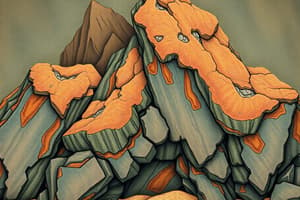Podcast
Questions and Answers
What type of igneous rock forms from magma that cools slowly beneath the Earth's surface?
What type of igneous rock forms from magma that cools slowly beneath the Earth's surface?
- Extrusive rock
- Sedimentary rock
- Intrusive rock (correct)
- Volcanic rock
Which of the following is a characteristic of metamorphic rocks?
Which of the following is a characteristic of metamorphic rocks?
- They have distinct bands or layers. (correct)
- They are always composed of a single mineral.
- They only form above the Earth's surface.
- They are formed from volcanic lava.
What differentiates granite from basalt?
What differentiates granite from basalt?
- Granite cools slowly and has large crystals, while basalt cools quickly and has small crystals. (correct)
- Granite is a sedimentary rock, while basalt is metamorphic.
- Granite is formed from lava, while basalt is formed from magma.
- Granite contains different types of minerals than basalt.
Which rock is formed from a parent rock through the application of heat and pressure?
Which rock is formed from a parent rock through the application of heat and pressure?
How do intrusive igneous rocks differ from extrusive igneous rocks?
How do intrusive igneous rocks differ from extrusive igneous rocks?
Flashcards are hidden until you start studying
Study Notes
Igneous Rocks
- Igneous rocks are formed when molten lava or magma cools down.
- Extrusive igneous rocks are formed on the Earth’s surface.
- Intrusive igneous rocks are formed beneath the Earth’s surface.
- Magma that cools slowly often has large-sized crystals.
- Magma that cools quickly often has small-sized crystals.
- Granite and basalt are examples of igneous rocks.
Metamorphic Rocks
- Metamorphic rocks are formed when existing rocks are changed by heat and/or pressure beneath the Earth's surface.
- Marble and slate are examples of metamorphic rocks.
- The original rock’s minerals may have different colours and also often have bands or layers when transformed into metamorphic rocks.
- Schist often shows layered bands.
- Gneiss has different coloured bands/layers.
- Increased heat and pressure make rocks stronger.
- Metamorphic rocks have different properties from the parent rock.
Studying That Suits You
Use AI to generate personalized quizzes and flashcards to suit your learning preferences.




